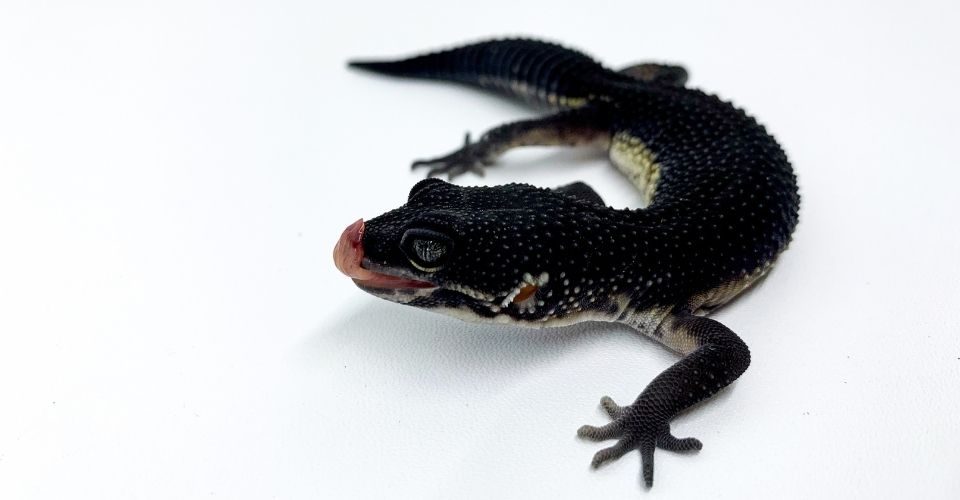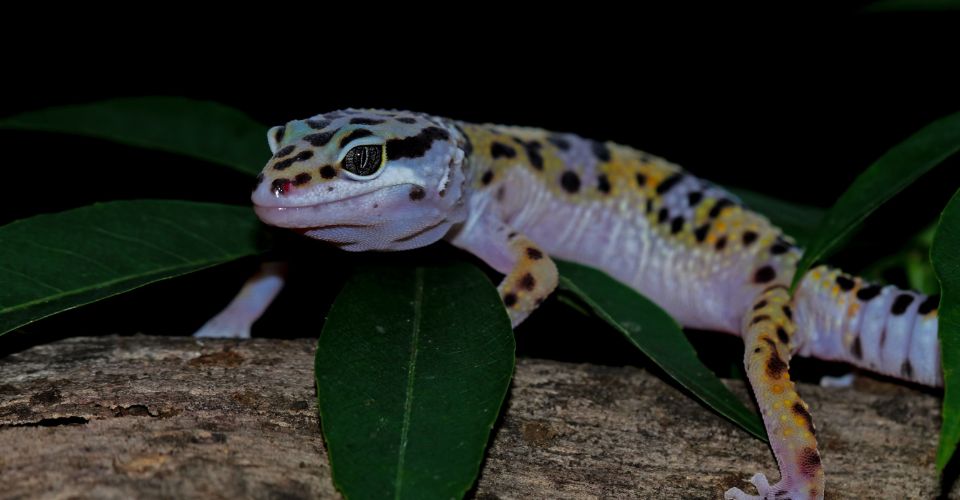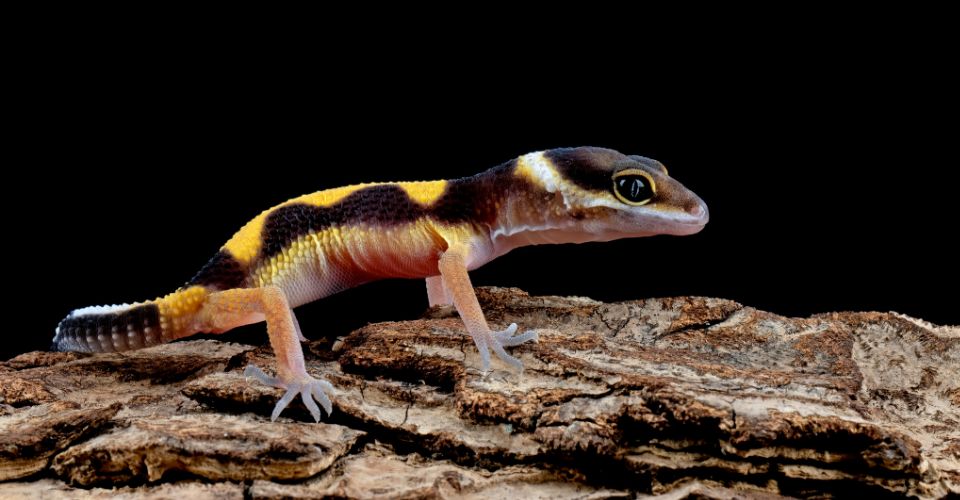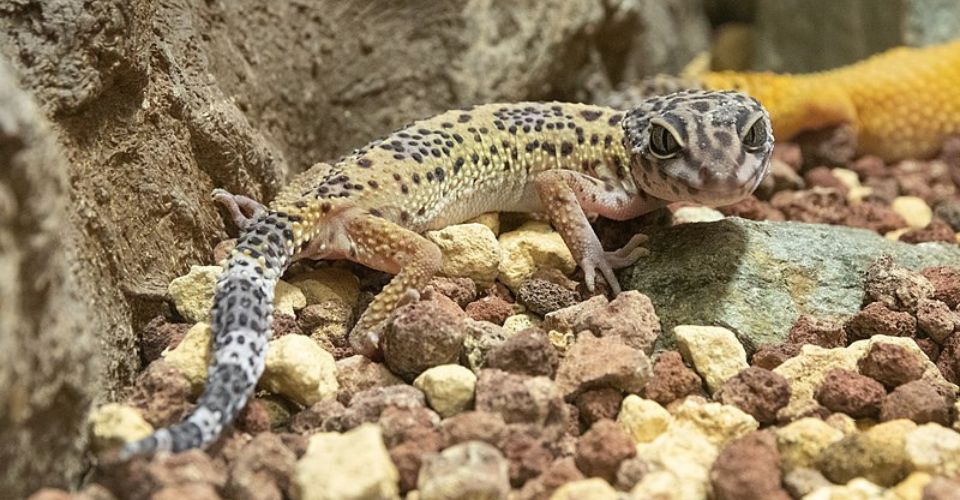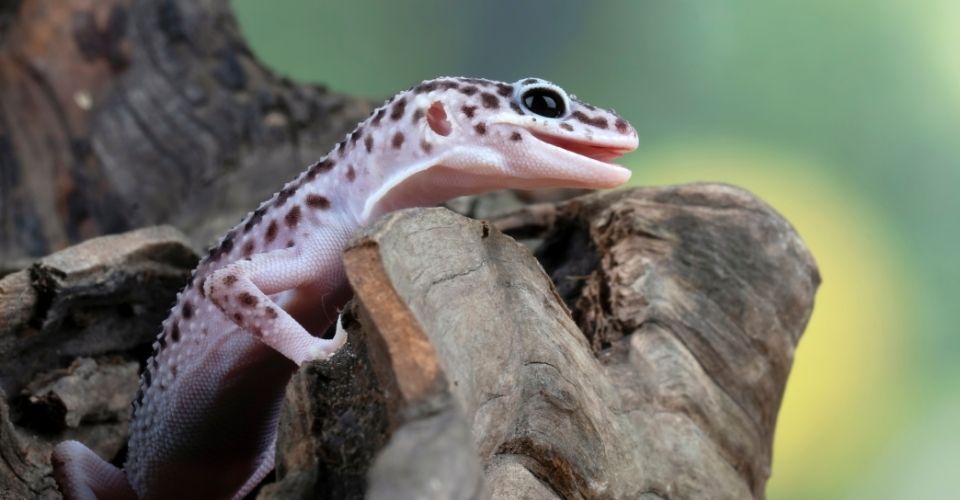Black color signifies strength and elegance. Anything in black—especially the pitch-black color giving off a dapper, polished look—is mesmerizing and reverential. That is why Black Leopard Geckos are quite popular among those who are fond of geckos.
Have you also been charmed by the Dark Night Leopard Gecko morph? Do you want to get yourself a Black Night gecko, but first, you want to familiarize yourself with this unique Leopard gecko morph—to know whether it would be a perfect fit for you or not?
Let us find out!
Before moving any further, you should take a quick look at the brief overview of this widely sought-after Leopard gecko morph below.
Black Night Leopard Gecko Morph Overview
Common Name:Black Night Leopard Gecko
Scientific Name: Eublepharis macularius
Size: Six to Seven Inches
Life-Expectancy: 15 to 20 Years
Color: Jet Black
Food: Insects (crickets, wax worms, mealworms)
Habitat: Dry and Rocky Area
Temperature gradient: 75 to 90 Fahrenheit
Humidity: 30 to 40 Percent
Lighting: Incandescent bulb
Substrate: Paper towel, fiber-based material, reptile carpet
Cost: Around $2000
Black Night Leopard Gecko Appearance
Technically known as hypermelanistic Leopard geckos as they have high levels of melanin, Black Night Leopard Geckos have long bodies with a triangular head at the front and a thick tail on their back. They are quadruped with generally five fingers in each. They are jet black in color with no pattern whatsoever, making them more appealing. Their captivating patternless black color is not the result of a genetic mutation; instead, it is a product of the dedicated line-breeding of dark Leopard geckos. They are developed by retaining the dark-colored Leopard geckos over successive generations.
Black Night Leopard Gecko Temperament
Agreeability and calmness are the dominant features in the personality of Black Night Leopard Geckos. They are quite friendly and usually do not mind their loving parents holding them. In fact, if you place a Black Night Leopard Gecko on your hand, it may wander all over your limb and eventually the whole body without getting frightened. They are highly inquisitive and eager to explore.
Due to such calmness and their dazzling looks, they are increasingly sought-after today.
Black Night Leopard Gecko Origin and History
Leopard geckos are natives of Asia’s rocky deserts and arid grasslands, mainly in Pakistan, Afghanistan, Iran, northern India, and western Iraq. However, Pakistan is the main country where these reptiles are collected. That said, Black Night Leopard Gecko is not found in the wild. As mentioned earlier, they are not developed by any accidental genetic mutation but rather by the devoted line-breeding of dark Leopard geckos. So the origin of the Black Night Leopard Gecko morph is attributed to the dedicated gecko breeders like Jayden Coleman and Ferry Zurmond.
Black Night Leopard Gecko Shedding
Baby and adult Black Night Leopard Geckos shed differently. While the former shed once in a week or two, the latter shed once every month or two months. Your Leopard geckos may experience difficulties in the shedding process, especially when the tank humidity is too low. If your gecko fails to shed their whole skin, it will experience necrosis and infection on unshed spots.
To avoid the shedding problems due to low humidity levels, you can introduce a humid hide in the Leopard Gecko Tank setup. So that when it’s time to shed, Leo could go to the humid hide. And if you notice your Black Night Leopard Gecko experiencing any difficulties in shedding its skin, or developing an infection, you should take it to your vet.
The Pros and Cons of Having a Black Night Leopard Gecko
Before you go get yourself a Black Night Leopard Gecko, you should take a quick look at the pros and cons given below.
Pros
They are easy to feed.
They are easy to breed.
They are friendly and like being held.
They do not require much space for the enclosure.
They are easy to tame.
They are exceptionally stylish due to their jet black color.
Cons
Various health problems are associated with them due to intensive breeding.
They are nocturnal: they are awake during the night and sleep during the day.
Though very rarely, they do bite.
They need a specially maintained environment in the tank.
They can spread diseases such as salmonella.
They are very costly.
Black Night Leopard Gecko Dietary Needs
Black Night Leopard Geckos, like other geckos, are insectivores—they only eat insects. You can feed them commercially available insects such as crickets, wax worms, butter worms, silkworms, and locusts. That said, you should never feed them insects like butterflies, cockroaches, moths, and butterflies.
In addition to their insect-based diet, Black Night Leopard Geckos also need calcium and vitamin D3 supplements. Most calcium supplements for reptiles have an added vitamin D3, so you don’t have to go but vitamin D3 separately. To give supplements to your Black Leopard Gecko, you can coat its feeder insects in the supplement powder.
While Leopard geckos can go 10 to 14 days without food, you should not keep your Black Night Leopard Gecko hungry on purpose for more than a few days.
Never feed your Leopard gecko any fruit because their stomach is not designed to digest fruits. Also, never feed it insects that are too big.
Black Night Leopard Gecko Feeding Chart
| Age Group | Meals Frequency | Insects Size |
| Baby | Every Day | About 0.4 Inch |
| Juvenile | Every Day | About Quarter an Inch |
| Adult | Every Other Day | Small to Adult Size |
Black Night Leopard Gecko Breeding Requirement
Black Night Leopard Geckos are easy to breed because they do not have any special needs and can breed for a longer period. Females produce about five clutches per season, and each clutch has two eggs.
They breed by mating, after which the females lay eggs that hatch to produce offspring. The temperature affects the gender of the baby: hotter temperatures result in a male, colder in a female.
You can begin Black Night Leopard Gecko breeding by following these basic steps:
- Place a male and a female Black Night Leopard Gecko in a tank. Do not place too many of them in a single tank.
- Keep the temperature between 72 and 75 Fahrenheit.
- After successful mating and laying, place the eggs in an incubator and maintain the temperature between 80 and 90 Fahrenheit, keeping the environment moist simultaneously.
How to Keep a Black Night Leopard Gecko Happy?
The key to the happiness of Black leopard Geckos lies in their proper care and maintenance, which can be done by the preservation of their correct ambiance. In this way, they will not only be joyous but stay healthy as well. A healthy Black Night Leopard Gecko is a happy leopard gecko, and they are the happiest when their vivarium mimics their natural habitat. Here is how you can do that:
- Keep the volume of the tank at least 20 gallons. Besides providing ample space for daily physical activities, it can also allow better environment management, such as the availability of enough water and the proper control of light and humidity.
- Provide the best Leopard gecko lighting setup to your Black Night Leopard Gecko by putting an overhead basking light on your Leopard gecko tank to stimulate the day-night cycle and to provide a temperature gradient of geckos’ liking.
- Maintain the temperature difference within the tank to allow your pet to regulate his body temperature. Aim for about 90 Fahrenheit on one side and 75 on the other.
- Keep the relative humidity levels between 30 and 40 percent. Geckos are desert-dwelling creatures, thus, requiring a rather dry environment. Furthermore, high humidity levels can jeopardize their respiratory and skin health.
- Make sure that that tank environment is clean to hinder the growth of fungi, algae, or bacteria.
- Avoid using sand as a tank bed, as it has a high risk of impaction. Cloth, paper towel, reptile carpet are the best choices for Leopard gecko substrate. Paper towel, fiber-based material, reptile carpet.
Black Night Leopard Gecko Common Health Issues
Black Night Leopard Geckos are prone to several health complications. Below we have discussed the most health issue that they might experience.
- Impaction: It happens due to the ingestion of indigestible substances, blocking the digestive system of the tiny gecko. If left untreated, it can cause system failure and, eventually, death. A clean tank can keep impaction at arm’s length.
- Dehydration: Improper diet and inappropriate humidity levels in tanks can cause dehydration in Black Night Leopard Geckos. Dehydration for a long time can severely impact their well-being. In extreme cases, it can cause death. To keep your Black Night Leopard Gecko hydrated, ensure ample water availability and maintain tank humidity.
- Respiratory Infections: Chest problems can occur very easily in Black Night Leopard Geckos if they are not kept in the proper temperature and environment. A gecko needs about 80 to 90 Fahrenheit during the daytime and 67 to 74 at night. Monitoring and controlling the tank temperatures can keep this problem at bay.
- Metabolic Bones Disorder (MBD): It arises due to the deficiency of vitamin D3 and can be exacerbated due to the lack of calcium intake. As a result, bones become fragile to the level that they cannot support the body structure. Calcium containing vitamin D3 supplements can help make up for the calcium deficiency and strengthen gecko bones.
The Signs That Your Black Leopard Gecko Is Not Healthy
If you observe the following symptoms in your Black Night Leopard Gecko, he might be unwell and need medical attention:
- Inability to breathe properly
- Weight and muscles loss
- Prolapses
- Vomiting
Is Black Night Leopard Gecko Good Pet?
Black Leopard Geckos are friendly, easygoing, and popular pets. They are absolutely fine as family pets. However, despite their easy-to-care-for nature, they do require a healthy diet and a controlled environment to live happily. Because of their friendly temperament, dazzling looks, and rarity, they are widely sought-after Leopard gecko morph, and that is why they have a hefty high price tag!
Now that you have familiarized yourself with the Black Night Leopard Gecko, You may want to check out other popular morphs such as Mack Snow Leopard Gecko or Giant Leopard Gecko.

